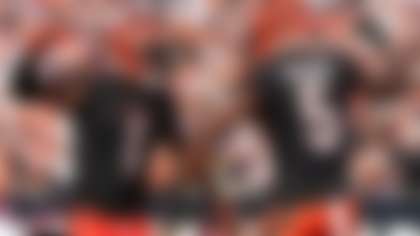Which teams got it right on fourth-down and 2-point conversion calls in Week 7 of the 2021 NFL season -- and which teams got it wrong? The Next Gen Stats analytics team uses the Next Gen Stats Decision Guide powered by AWS to break down the numbers behind the decisions that shaped the game.


Frank Reich mostly by the book on fourth down
The Colts faced nine fourth-down decisions against the 49ers on Sunday Night Football -- in pouring rain and heavy winds, mind you -- and they made the right call on eight of them, according to the NGS Decision Guide.
THIRD QUARTER: With 11:28 remaining and the Colts (leading 13-12) facing fourth-and-1 from the 49ers' 49-yard line, Jonathan Taylor converts on a 3-yard run (fumble recovered by teammate Ashton Dulin).
The numbers strongly favored going for it here -- by a factor of 6.6 percentage points in expected win probability value -- in what was one of just two recommended go-for-it fourth-down scenarios on the night for Indy. (The other was a fourth-and-4 call later in this drive, when the Colts appeared to take a delay-of-game penalty in an effort to bait the defense into going offsides before punting.) The offense had a 68 percent chance of converting in what was, according to NGS ball-tracking technology, a true 1-yard to go situation, and the expected win probability with a conversion was set at 60 percent. If the Colts punted, their expected win probability would have dropped to 47 percent. By combining the (high) likelihood of conversion with the hypothetical outcomes, we find going for it -- by more than 6 percentage points in win probability value -- is the optimal call.
This was Reich's eighth time this season facing a fourth-and-1 situation when the numbers indicated going for it was the best decision. The Colts kept the offense on the field for seven of them -- a total shared by only the Cowboys, Raiders and Lions.


Dan Campbell keeps the pedal to the metal
Pegged as heavy underdogs in a road matchup against the Rams, Campbell and the Lions chose to embrace a high variance of outcomes; they pulled off a surprise onside kick after scoring on their opening drive and went for it three times on fourth down, including two fake punts.
FIRST QUARTER: With 11:01 remaining and the Lions (leading 7-0) facing a fourth-and-7 from the 50-yard line, Jack Fox completes a fake-punt pass to Bobby Price for 17 yards.
The Lions' offense had the ball twice before the Rams' offense could even possess it once to start the game, thanks to a successful onside kick. And when this situation arose at midfield, Campbell and Co. were apparently still not ready to give the ball back to Los Angeles' potent offense. We had the optimal call here as a punt, by 1.2 percentage points in expected win probability, driven by a 37.3 percent chance of converting on fourth-and-long. However, this assumes a normal play from scrimmage. Campbell had the element of surprise working in his favor with the fake punt, and his aggression was rewarded with Fox's wide-open completion to Price (5.2 yards of separation when the ball arrived).
THIRD QUARTER: With 10:02 remaining and the Lions (trailing 17-16) facing a fourth-and-8 from their own 35-yard line, C.J. Moore takes a direct snap on a fake punt for a 28-yard gain.
Campbell returned to the well for another fake punt early in the third quarter -- but this time, he went with a direct snap to the up-man, Moore, instead of trying for a pass. The NGS Decision Guide agreed with Campbell on this decision, finding an advantage of 1.7 percentage points of win probability. The Lions had just a 33.0 percent chance of converting, given the long distance to go, but that is without considering that the Lions also caught the Rams with just 10 players on the field on the play.
THIRD QUARTER: With 6:19 remaining and the Lions (trailing 17-16) facing a fourth-and-1 from the Rams' 18-yard line, D'Andre Swift was stuffed for no gain, and the Rams took over on downs.
The Lions stalled out in the red zone on that same drive when they chose to go for it again instead of attempting a field goal to take the lead. The NGS Decision Guide strongly recommended going for it this time, with a +4.4 percentage point difference in win probability. The recommendation was driven by the high chance of converting (71%), given the offense had just 1 yard to gain.
While the Lions came up short in the end, the team's decision-making process was evidently sound. Despite Detroit's winless record, Campbell's aggressiveness and creative play-calling have kept this team competitive in all but two games this season.


Brian Flores revealing a fourth-down pattern?
The Dolphins faced four fourth-down situations Sunday, with the NGS Decision Guide recommending going for it on all four, though by non-obvious margins (i.e., less than 2 percentage points in expected win probability value). Miami kicked each time (three punts and one field-goal attempt, the latter of which was blocked), resulting in a net loss of 5.1 percentage points in expected win probability value, based on the information known before the result of each play (0.8, 0.8, 2.0, and 1.5 percentage points respectively).
As we go deeper into the season, patterns start to emerge around teams' risk tolerance on fourth down. Through seven games in 2021, Flores has faced 19 fourth-down decisions in which the numbers said going for it was the optimal decision and the game was still within reach (we define this as the team having at least a 10 percent chance to win the game prior to the fourth-down play). The difference in value between going for it and kicking was greater than 2 percentage points on five of those fourth downs -- and Flores kept the offense on the field four times. The value of going for it (in expected win probability value) was between 0 and 2 on the other 14 occasions -- and Flores opted to kick each time. (This includes all four fourth-down situations on Sunday against the Falcons.)
While the sample size is small here, the numbers do suggest Flores and Co. are using some type of heuristic to aid in fourth-down decision-making. Perhaps the 2-percentage point threshold, or something like it, is an indication of a quantitative-based risk tolerance level.


John Harbaugh goes aggressive on toss-up call
FOURTH QUARTER: With 11:43 remaining and the Ravens (trailing 27-17) facing a fourth-and-7 from their own 38-yard line, Lamar Jackson fails to convert, throwing an incomplete pass.
Trailing by two scores late in the fourth quarter, Harbaugh made one of the more aggressive decisions of the season so far by going for it here, on what we had as a near toss-up situation -- the guide favored going for it by a mere 0.2 percentage points in expected win probability value.
If the Ravens had converted on fourth-and-7 (and we had the distance closer to 8 yards, according to our ball-tracking data), their chances of winning would have increased from 10 percent before the play to 19 percent as a result of the conversion. We know Jackson and the offense ended up turning it over on downs, with the Ravens' chances of winning dropping to 7 percent. Cincinnati scored on a subsequent 21-yard touchdown run by Joe Mixon, which all but ended the game. Baltimore's win probability never rose above 1 percent the rest of the way.
Follow the Next Gen Stats team on Twitter.












